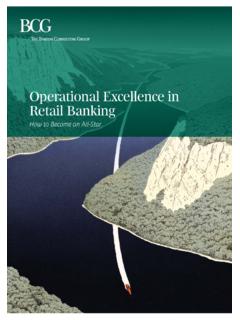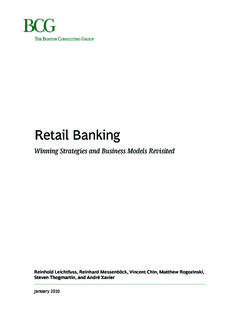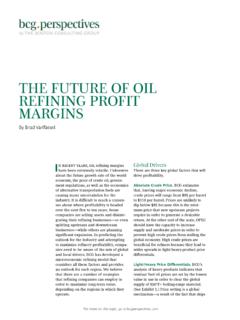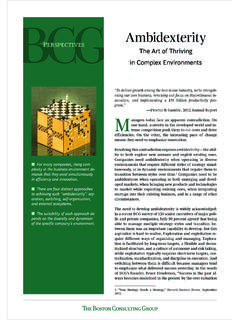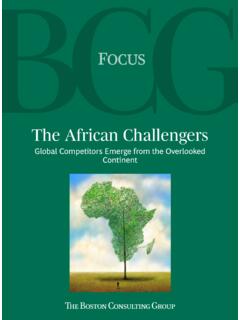Transcription of Keep Your Working Capital Working - BCG
1 keep your Working Capital WorkingLessons from Consumer Goods CompaniesF The Boston Consulting Group (BCG) is a global manage-ment consulting fi rm and the world s leading advisor on business strategy. We partner with clients in all sectors and regions to identify their highest-value opportunities, address their most critical challenges, and transform their businesses. Our customized approach combines deep in-sight into the dynamics of companies and markets with close collaboration at all levels of the client organization. This ensures that our clients achieve sustainable compet-itive advantage, build more capable organizations, and secure lasting results.
2 Founded in 1963, BCG is a private company with 70 offi ces in 41 countries. For more infor-mation, please visit Y W C W keep your Working Capital Work ingLessons from Consumer Goods CompaniesWhether they in-tend to grow or-ganically or through mergers and acquisitions, companies must maintain a strong cash position. However, as the reces-sion winds down and companies be-gin to return their attention to grow-ing and gaining market share, many are losing their focus on best-in-class cash- management practices. By doing so, they run the risk of weak-ening a strategic advantage. The Boston Consulting Group recent-ly analyzed the net- Working - Capital performance that is, how well com-panies optimized their current assets and liabilities of 122 fast-moving- consumer-goods (FMCG) companies across fi ve global sectors, from 2006 through 2009.
3 (See the Appendix for our methodology and for company rankings.) Our analysis identifi ed three troubling recent eff orts to better manage their cash, the companies in our study were able to improve their cash-conversion cycles (CCCs) just a mere days per year, on average, since 2006. The CCC measures how many days a company s net input is tied up in its production and sales processes before it is converted into cash through sales to customers. The average Working - Capital per- formance for our entire data set masked a signifi cant disparity be-tween the best-performing com-panies and all the others. While the leaders in cash management improved their CCCs by an aver-age of 31 days over two years, many of the remaining companies saw their cash positions deterio-rate and their CCCs lengthen signifi cantly.
4 We estimate that if the underperforming companies in our sample could improve their CCCs to match the peer average, they would enhance their total av-erage net- Working - Capital perfor-mance by $64 billion. And if un-derperformers could match the top-quartile companies, average net- Working - Capital performance for the 122 companies in the sam-ple would improve by $121 bil-lion. Such gains would translate into the companies in our study realizing a range of savings be-tween $100 million and more than $1 billion each money that they could use to fund growth. Many companies that had been actively managing their cash posi-tions in response to the downturn now lack the discipline to sustain these initiatives.
5 As a result, many improvements that had been achieved in Working Capital are be-ginning to erode and even vanish. Savings Through Integrated Cash management Applying practical levers to manage cash is only the fi rst step in sustain-ing a world-class cash- management position. The next and even more critical step is making the initiative stick. To do that, the entire organiza-tion must foster a think cash men-tality in all aspects of its daily activi-ties. BCG s integrated cash-manage-ment framework not only produces quick cash savings, it also ensures on-going improvements for the long term by enabling companies to con-tinuously optimize net Working capi-tal on their our work with consumer compa-nies over many years, we have found that an integrated approach to cash management can reduce net Working Capital by 20 to 40 percent and sus-tain that reduction over time.
6 For in-stance, one international consumer-goods client increased its cash fl ow from operations by 38 percent in just one year, driven primarily by im- T B C G provements in net Working Capital . The increase translated into more than $250 million in additional cash or more than $20 million a month a portion of which the com-pany reinvested in growth. A er this initial success, the company set up a program to continue to improve its cash across the sectors we ex-plored in our analysis, we found that the food and beverage sector scored the best improvement in average CCC, reducing it by days a year. Companies that carry categories in addition to food and beverages (such as tissues, household cleaning, and personal care products) saw their sector s average CCC decrease only one day per year.
7 The spirits sector showed a particularly long cash-con-version cycle of 251 days because the business model inherently requires large inventories (o en to age specif-ic products). This sector s perfor-mance worsened over the past years, however, with the average CCC lengthening an average of days per year since 2006. (See Exhibit 1.)When we focused on each of the fi ve product sectors, we found substantial potential for improvement in all sec-tors. (See Exhibit 2.)Food and Beverage. Large food and beverage players had the best aver-age CCC at 37 days. We attribute this largely to the infl uence these compa-nies hold in the market. They are able to negotiate advantageous pay-ment terms with suppliers and dis-tributors and can devote signifi cant resources to inventory reduction.
8 Moving the underperformers in this sector up to the peer average would further reduce the sector s average CCC by 20 days. The top performer among the food and beverage com-panies achieved a CCC of 25 days 62 days shorter than the sector s conversion cycle (CCC) in days 706030260250504023020 Average change since 2006(days per year)All sectors Spirits sector FMCG sector sector sector and beverage sector 1. Cash Conversion Cycles Vary Across Consumer Goods SectorsSources: Bloomberg; BCG : Exhibit reflects data for 116 companies; six companies were excluded from the analysis due to missing data or incomparable across sectors, we found that the food and beverage sector had the best improvement in average Y W C W Food.
9 We estimate that the food sec-tor has the potential to improve its CCC by 25 days on average, with im-provements to supplier payment terms saving about 10 days. Diff er-ences among the CCCs of food com-panies refl ect diff erences in focus on either cash fl ow or growth. The top performer among the food compa-nies achieved a CCC of 17 days, which is 29 days shorter than the sec-tor The average CCC for the beverage sector is 65 days. This cycle appears lengthy in comparison to that of the food sector, but beverages tend to be stored for longer periods of time. Diff erences among beverage companies CCCs usually result from their diff erent business models. For example, some beverage companies partly outsource bottling and there-fore have a shorter CCC than compa-nies that bottle in-house.
10 The top per-former of the beverage companies achieved a CCC of 46 days, which is 111 shorter than the sector s The average CCC for the spirits sector is 251 days, largely be-cause some spirits must be stored for long periods. Indeed in this sector, long cycles aren t necessarily bad be-cause the products that require aging typically have higher price points and command higher margins than those that don t. But several other factors contribute to lengthy CCCs, such as remote plant locations, weak-er bargaining power, and less focus on cash management as a result of already high margins. The total po-tential improvement for the sector on average is 43 days, with most gains achievable through improve-ments to payables.

